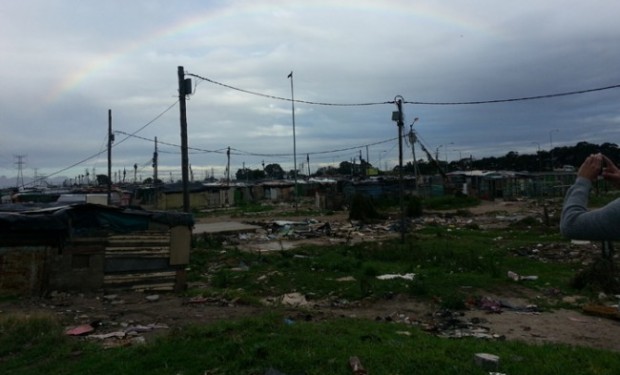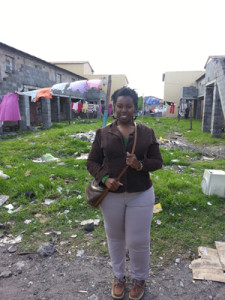Campbell Law School students excel in North Carolina and across the nation: South Africa (ZA)
One of my most memorable experiences in ZA was the walk through Langa.
[Editor’s Note: The Campbell Law Observer is taking a break from its usual editorial cycle to present first-person accounts from our law students who have enjoyed summer internships across the nation, and in the case of this writer, across the world. This is the final of four submissions to be published during the first week of the fall of 2013 semester.]
I had always wanted to study abroad and summer 2013 would be my last opportunity. After I looked through all of the study abroad options, I settled on South Africa (ZA). I experienced many different things while in ZA: I stood behind President Obama during his address at Cape Town University; hiked Table Mountain (one of the seven world wonders); attended a cultural celebration; interned at the South Africa Commission on Gender Equality; took classes at the University of Western Cape; and celebrated my birthday South African style. My stay in ZA was filled with new knowledge and fantastic reminiscences. There are many memories that I will forever cherish from summer 2013 in Cape Town, ZA, but one of my most cherished moments took place in a place called Langa.
Although the period of apartheid is over, the feel of and the effects of apartheid are still prominent in ZA.
In the seventeenth century ZA was colonized by the English and the Dutch. After ZA procured its independence from England, power was shared between two groups. In the 1940s the Afrikaner National Party gained a strong majority and began the practice of apartheid. In 1948, racial discrimination was institutionalized in ZA. The apartheid laws were strategically created as a mechanism to secure control over the economic and social system. The initial aim of apartheid was white dominion, and further separation of races.
In order to further the systematic control, legislation was enacted and required all residents to register their race. Such legislation produced a racial caste system which put whites supreme, then “coloureds” and then blacks. 1 The intention of the Afrikaner National Party was to segregate whites and coloureds and to expel all blacks from the Western Cape. The Group Areas Act provided that whites be zoned in the desired areas.
The Population Registration Act mandated all Capetonians over age 16 to carry identification that specified their race. Race laws in the years following would change all aspects of ZA. Education, housing, jobs, theatres, toilets, parks were enjoyed at the complete exclusion of blacks, and to a partial disadvantage of coloureds. All but whites were disadvantaged and politically disenfrancished.
Although apartheid is no longer the law of ZA, the effects of apartheid have left the lives of blacks and coloureds in almost complete destruction. The victims of apartheid still are treated unfairly. The retired Judge Yacoob of the South Africa Constitutional Court was my Constitutional Law professor, he stated that section 9(1) of the South Africa Constitution does not say everybody has the right to equality before the law—but that everybody is equal before the law! Residents of Langa, and other populations may be seen as “equal” but have not yet achieved equality.
Despite the oppression in the hearts of Langa residents, they were some of the nicest people I met in ZA.
During my time in Cape Town I was able to visit Langa. Langa is a township just outside of Cape Town that was designated for blacks during apartheid. On that particular day, while on the way to the Langa culinary school for lunch, many of the Langa schoolchildren were walking home. Some students wore uniforms, some wore regular clothes. As I arrived for lunch, I went to wash my hands and realized there was no hot water, and only dingy bar soap. The bathrooms were quite small and anybody passing by could look into the stalls from the street. Despite no hot water and no accessible sanitation score, I opted to erase the lack thereof from my mind, use hand sanitizer, and try the food. Although scared at first, I went back for a second round of my first African meal.
After lunch our study abroad group walked into the township further. The first observation was the number of stray dogs that roamed the streets. The first stop was at some hostels. The hostels were worn down, but were probably the best housing that I generally saw for blacks in Langa. The hostels were originally for single migrant workers during early apartheid. Today the living conditions in the hostels are deteriorated. Since the oppression among black people was so severe, these families are stuck living life day to day—trying to make ends meet—with no practical way out. Each hostel held about five rooms. I was able to go in a room and see that it was smaller than my college dorm room without the bathroom. That same tiny room housed a family of seven. The hostels also had a cement entry area/ living room type area, which is where children from the various rooms within the hostel slept once they turned nine because the rooms were so small. The hostels also lack hot water and electricity. As I walked between hostels, I had to navigate through clothing lines as well as around dead rats and barefooted children who were playing outside.
It was at that moment that I felt my heart smile.
Life for those who live in hostels is terrible, while the housing for whites was generally upscale. I moved on to visit a Dalukhanyo 2 Pre-School, further into Langa. As we approached, we saw the children playing outside in a gated playground behind the school. I could not help but notice that despite the lack of washing machines, and lack of adequate housing, the children were rather well dressed. The children saw us approaching, and as we entered the gates instantly we were bombarded with hugs and love. It was at that moment that I felt my heart smile. The love for these children produced a swelling joy in my heart that I will never forget. I had never felt so much love in such little time—at first sight. For fifteen minutes my heart did leaps and played as I enjoyed the presence of the Langa children, and they enjoyed ours.
We stayed with the preschoolers for what seemed two minutes, but was actually a still short fifteen before being rushed off to another part of Langa. Walking away from those school gates was the hardest goodbye I had to say while in ZA. As we walked on, we passed by homes, hair salons, barber shops, and restaurants, which were made from metal, plywood, and other scraps. I was in an “informal development,” a shantytown. These structures were crafted from scraps and trash, yet these structures were what housed the Langa children, it was their home.
As I walked away from Langa that day my heart glowed, but longed once more to see the Langa school-children. My heart craved to be back at Dalukhanyo Pre-School. As I looked back in retrospect on the way back to my fully furnished hotel room that had electricity and hot water, I was humbled at the fact that the children of Dalukhanyo have no heat, no hot water, and some no socks, but still were able to live an optimistic and positive life.
I will forever remember the warm embraces of the Dalukhanyo Pre-Schoolers.
Not a day has passed where my mind has not taken a trip back to Dalukhanyo Pre-School and Langa, my heart still remains there. I am amazed by the loving nature of the Langa schoolchildren. I will forever remember the warm embraces of the Dalukhanyo Pre-Schoolers. That moment is the most memorable moment in my South African experience. That moment was one of the happiest moments that my heart has ever felt. Blacks were segregated to Langa during apartheid, but with their economic ability also taken, Langa residents were left with no escape. The chances that these children will make it out of Langa were described as “slim to none,” yet the children were incredibly loving with scarcely the most basic biological needs.
My most memorable moment was not standing behind President Obama, reaching the top of Table Mountain, nor the massive cultural celebration, but the embrace of the Langa children. I feel that all Americans have a lot we could learn from the Dalukhanyo Preschoolers in Langa, and I hope to return to Langa one day soon.
1 “Coloured” includes any person who is neither white, nor black. Coloured was a name for those who were previously declared Chinese, Indian or Malay. If officials had to determine whether an individual was to be counted as white or black, they would administer a test by sticking a pencil in that individual’s hair because the curliness of a person’s hair was considered an “indicator of blackness.” If the pencil fell out of the hair, that person was considered white; if the pencil stayed in the hair, that person was considered black.
2 Dalukhanyo means “to bring light” in Xhosa (one of the official ZA languages).


